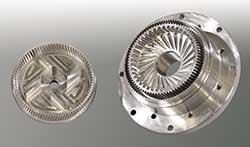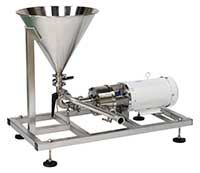Taking the Measure of Mixing Technologies and Practices
PROCESSING
Mixing in all its permutations remains a common and critical unit operation in food processing. Representative examples include mixing liquid sweeteners into water-based beverages, mixing solid ingredients into soups and sauces, mixing solid ingredients into seasoning bases, and mixing carbon dioxide into carbonated beverages.
In all cases, energy is required to ensure homogeneous mixtures. How much energy? How is it best delivered? How long should it take to achieve good mixing? And, most critically, how does one know that the desired results have been achieved?
These are some of the important questions encountered. They are more difficult to answer than might be supposed.
The last question actually has the simplest answer, but applying the answer is not always easy. Since the overall objective of any mixing operation is to achieve consistent results, the way to measure consistency is statistically. Specifically, the standard deviation of a composition is the accepted measure of consistency among samples of supposedly the same population, such as individual bags from a batch of dry seasoning mix or individual bottles from a batch of beverage mix.
Much mixing is done in batches because formulation often involves addition of individual components in a recipe. Theoretically, one wants the standard deviation of the measured amount of each component to be small, but, in practice, one or two ingredients are used to represent the composition of the complete mixture. This may be because it is hard to analyze for every ingredient because not all are equally significant and because it is costly to do so much analysis.
In many dry solid mixtures, salt is a relatively large component. It is relatively easy to analyze, so the standard deviation of salt content is a good measure of mixing effectiveness. Some operations take a single sample after mixing for a set time as a quality check. This is relatively meaningless as a measure of consistency. All it really indicates is whether all the components were added in about the correct amounts. As such, it is a useful check.
To determine mixing time in a given mixer for a given formula, multiple samples must be taken from different locations in the mixer at various elapsed time periods. It requires about 10 samples to calculate a meaningful standard deviation. When the standard deviation stabilizes at a low value, the optimum mix time is identified. In solids mixing, it is actually possible to overmix, so an optimum time exists. Unfortunately, the optimum time may change in different equipment, with different formulas, and with different batch sizes.
 As I have pointed out before, it is frequently tempting for operations to overfill dry mixers in a misguided effort to increase production. Because all mixing relies on bulk convection of the components, some free volume in a mixer is necessary. Overfilling can lead to poor mixing or excessively long mix times. Many dry mixers are horizontal vessels with one or more shafts and paddles or ribbons to move the contents. Such mixers should be filled to just over the shaft, with the ends of the ribbon or paddles just showing. This is typically about 70% of the theoretical volume.
As I have pointed out before, it is frequently tempting for operations to overfill dry mixers in a misguided effort to increase production. Because all mixing relies on bulk convection of the components, some free volume in a mixer is necessary. Overfilling can lead to poor mixing or excessively long mix times. Many dry mixers are horizontal vessels with one or more shafts and paddles or ribbons to move the contents. Such mixers should be filled to just over the shaft, with the ends of the ribbon or paddles just showing. This is typically about 70% of the theoretical volume.
To perform a mix time determination, the mixer should be loaded with the full recipe, run for a short period, and stopped (for safety reasons). Then samples may be taken with a sample thief (a device that allows recovery of small samples from below the surface) and the samples analyzed for a representative component. The standard deviation is calculated for each time period and plotted against time. There are mathematical manipulations of the statistical results that may linearize the curve, but the concept is the same.
For an ongoing operation, the standard deviation can be calculated for any population that is assumed to be the same. For example, in one case, bags of seasoning mix that contained salt and antioxidants were analyzed from several different batches. If the mixing operation were consistent, one would expect the standard deviation within batches to be the same from batch to batch. In this case, they were not. The consequence could be serious, because there are federal regulatory limitations on the allowable antioxidant concentrations in the final product. If the salt concentrations are not consistent, it is reasonable to assume that the antioxidant concentrations are not either.
--- PAGE BREAK ---
The vendor of the seasoning mix, in this real example, insisted that the process capability index indicated that the process was under control. However, the process capability index relies on the specification spread, or difference between the high and low acceptable concentration, divided by six times the standard deviation. The concept is that specification limits are theoretically set by customer requirements and the standard deviation is a measure of the process operation. Six times the standard deviation captures well over 99% of the possible range of concentrations, if they are normally distributed, which is a fair assumption. (This is the origin of the emphasis in modern manufacturing on six sigma, since sigma is the conventional symbol for standard deviation.)
The fallacy here is that, in fact, the vendor set the specification limits, not the customer, and set them so wide that the process did generally comply. In reality, the specifications should be much tighter, and then the process would not be found capable because the standard deviations were inconsistent and relatively large. To me, these facts were an indication of some fault in the dry mixing operation. Unfortunately, this situation is pretty common.
Liquid Mixing
Liquid mixing of mutually soluble materials or of solids into liquids is usually considered to be relatively easy, but it can be tricky. In another case from my experience, a food color was added to a large batch of a beverage. The batch of liquid was mixed by pumping the contents of a tank through an external pump that was fed from the bottom of the tank and discharged near the top.
Now in mixing, in general, one parameter that can be used for scale-up is the dimensionless number Nt, in which N equals the rotation speed of an agitator and t equals time, in consistent units, so if N is in rotations per minute, t is in minutes. This value can be thought of as the number of turnovers to achieve uniformity. For a given formula in a mixer with geometric similarity, one wants to keep the value constant in scale-up to achieve comparable results. (There are other parameters that also matter in mixing scale-up, but for now, the concept of turnovers is the important one.)
In the liquid mixing example, a typical batch was 2,000 gal and the pump rate was 20 gal/min. From experience with other products, typical mix time was about 20 min. In this specific case, inconsistency in color was noted. Upon reflection, it was realized that it would take 100 min to achieve one turnover of the tank contents, and that would probably have not achieved consistency. Certainly 20 min was not long enough. Changes were suggested, including bubbling nitrogen through the tank, to achieve greater agitation. (A mechanical agitator would have been good, but was impractical because of physical constraints.)
The key point here is that an adequate number of turnovers is required in any form of mixing, just as, in solids mixing, the right amount of head space and correct time are necessary.
 Continuous Mixing
Continuous Mixing
Continuous mixing is a feeding challenge more than an agitation issue. Hapman (www.hapman.com) has developed a mobile, trailer-mounted mixing system for generating aqueous solutions from dry ingredients at field locations. Known for their conveying systems, in this case, Hapman uses an eductor to draw in dry ingredients to a moving liquid stream. The anticipated applications are field operations, such as well drilling, but one could imagine its use in agricultural and harvesting situations, for fertilizers, pesticides, and sanitizing or cleaning operations.
Silverson (www.silverson.com) is one of many firms that offer mechanical mixers for incorporating powders into liquids, using the rotor/stator principle. The mixing workhead consists of a high speed centrifugal type rotor, which rotates within a fixed stator. This causes a powerful suction, drawing liquid and powdered ingredients into the head where they are subjected to intense high shear before being forced out through perforations in the stator, then projected back into the mix. When used in powder/liquid mixing applications, the self-pumping mixer draws liquid from the bottom of the process vessel, through a pipeline into the high shear mixing workhead, then recirculates it back to the top of the vessel. Powder is added to a feed hopper designed to minimize bridging and rat-holing, thus minimizing aeration. A valve is opened, and the powder is sucked into the high velocity fluid stream just prior to the high shear zone of the mixer, instantaneously dispersing and hydrating the powder. This eliminates the formation of “fish eyes”—lumps of powder with wetted outsides that prevent water from hydrating the interior—a common problem encountered when adding starches or gums directly into water in the vessel.
The Silverson device can be used for continuous or batch mixing if it is provided with a reliable solids feeder, for continuous mixing. Reliable solids feeding is a complex topic in itself. Typical solutions include vibratory feeders, weigh belt feeders, and loss-in-weight feeders coupled with a flow control device, such as star wheels or screw feeders. Solids can bridge or flood, rendering flow rate inconsistent. Mixing still requires adequate agitation, but consistent flow is most critical in continuous mixing.
 J. Peter Clark, Ph.D., CFS, Contributing Editor,
J. Peter Clark, Ph.D., CFS, Contributing Editor,Consultant to the Process Industries, Oak Park, Ill.
[email protected]
